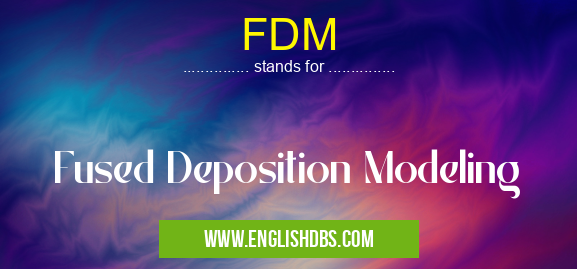What does FDM mean in PHYSICS
Fused Deposition Modeling (FDM) is an additive manufacturing technology that works by extruding molten material in layers to create three-dimensional objects, one layer at a time. It has become a popular choice for the production of functional models, prototypes, and end-use products. This article will introduce you to FDM technology and provide answers to some Frequently Asked Questions.

FDM meaning in Physics in Academic & Science
FDM mostly used in an acronym Physics in Category Academic & Science that means Fused Deposition Modeling
Shorthand: FDM,
Full Form: Fused Deposition Modeling
For more information of "Fused Deposition Modeling", see the section below.
Essential Questions and Answers on Fused Deposition Modeling in "SCIENCE»PHYSICS"
What is FDM?
FDM stands for Fused Deposition Modeling, which is an additive manufacturing process that utilizes thermoplastic filament to build 3D objects from the ground up, layer-by-layer. It can be used to create anything from small parts and models to large end-use products like furniture and appliances.
What materials can be printed with FDM?
Common materials used in FDM printing include PLA, ABS, PETG and nylon as well as composites like carbon fiber or wood filaments. Each material has its own properties so it's important to choose the right material for your project.
How accurate is FDM printing?
The accuracy of an object produced using an FDM printer depends on a variety of factors including the layer resolution setting and type of materials used. Generally speaking, standard resolution prints have a minimum layer thickness of 0.2mm and can achieve resolutions up to 0.1mm with higher quality prints.
Does FDM require post processing?
Yes, most 3D printed parts created with an FDM machine require some form of post processing. This could involve sanding down any overhangs or removing support structures from the print if they were used during printing.
Is FDM petroleum based?
Most plastics used for 3D printing are petroleum based but there are also renewable bioplastics available like PLA and Biodegradable PHA which are derived from plant-based sources like corn starch or sugar cane extractions instead of traditional fossil fuels.
Final Words:
While there are many types of 3D printing technologies available today, Fused Deposition Modeling (FDM) remains one of the most widely used due to its affordability and ease-of-use. Its ability to work with a wide range of materials means it's suitable for a variety of applications including prototyping, modeling and producing end-use parts such as furniture or appliances. We hope this article has answered some common questions about this type of 3D printing technology!
FDM also stands for: |
|
| All stands for FDM |
